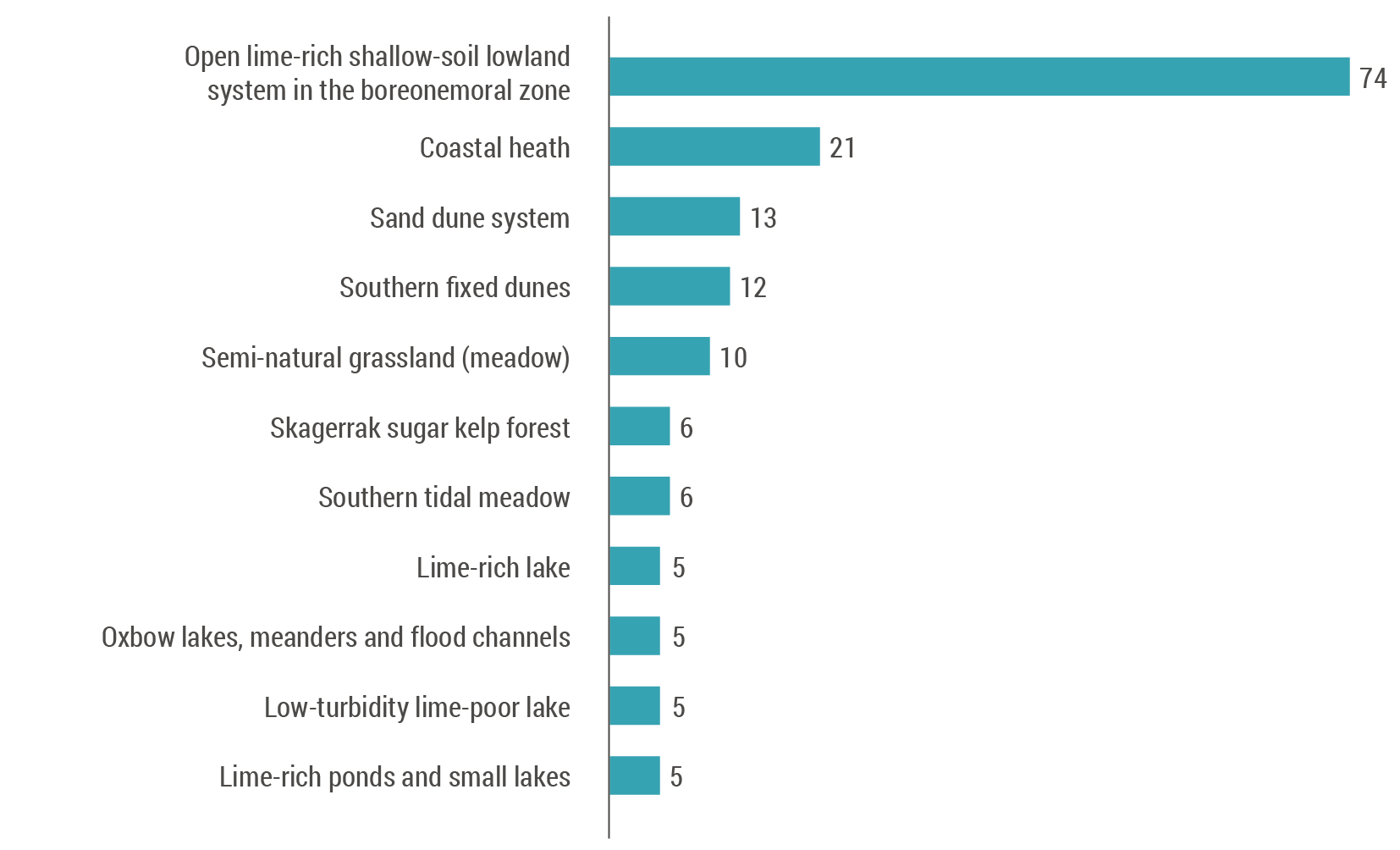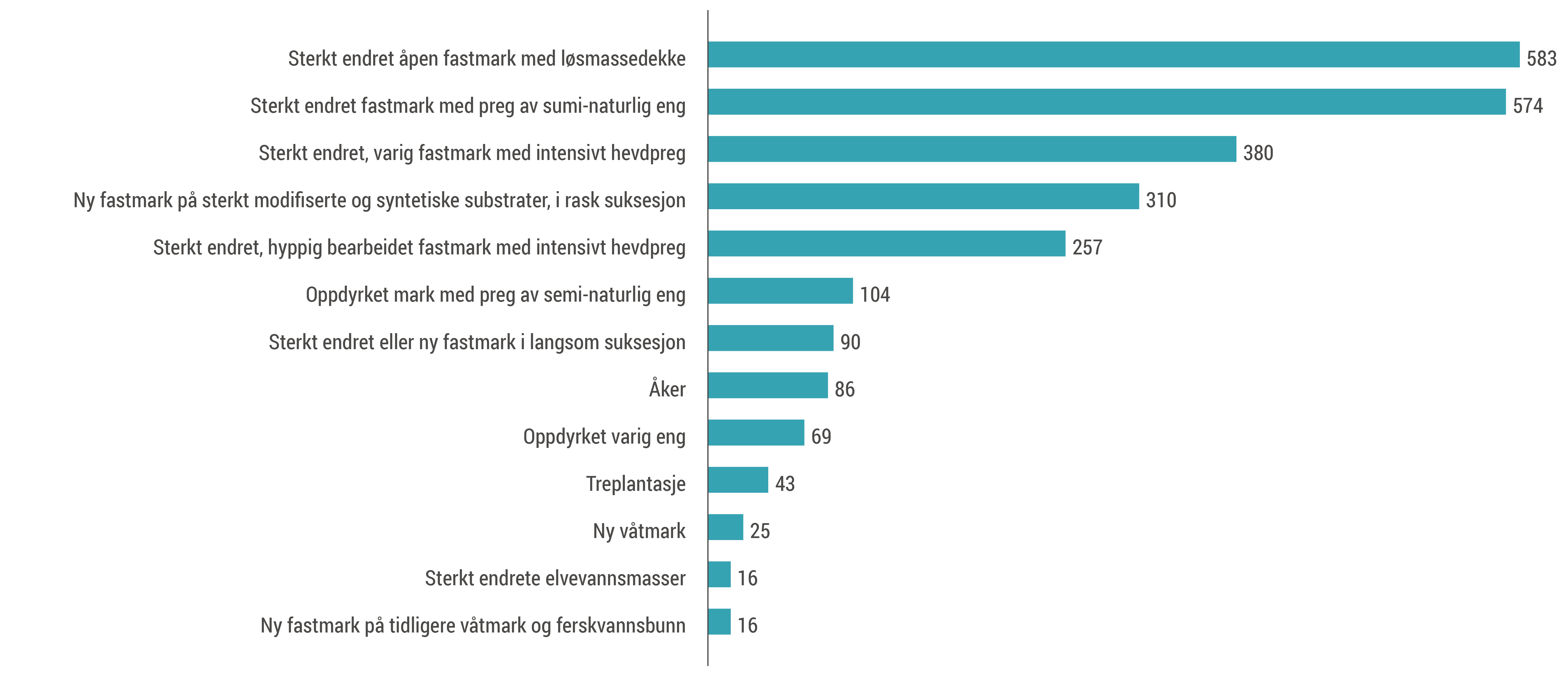Alien species in threatened nature types
Many alien species become established in Red Listed nature types so that the nature type changes in character. Nonetheless, it is in nature which has been greatly modified by humans that the majority of alien species become established.
- Innhold
- Changes in the composition of species in Red Listed nature types
- Open nature types below the treeline are most affected
- Most alien species become established in heavily modified nature
Changes in the composition of species in Red Listed nature types
All of the 96 species which are identified can lead to changes in threatened or rare nature types. This can imply changes in the composition of species, in the stability of sand or in the water saturation or nitrogen content of the soil. An example of such an alien species is sponge seaweed Codium fragile which can dominate in patches in areas that are normally occupied by serrated wrack Fucus serratus and/or sugar kelp Saccharina latissima. More than 5% of the Red Listed nature type sugar kelp forest in Skagerrak, and sugar kelp forest in the North Sea, are negatively influenced by sponge seaweed. Another example is low juneberry Amelanchier spicata which can outcompete species that naturally belong in the Red Listed nature type open lime-rich shallow-soil lowland system in the boreonemoral zone.
Open nature types below the treeline are most affected
One species can colonise many nature types and some species can colonise several Red Listed nature types. Open threatened nature habitats below the treeline have the greatest number of alien species. Open lime-rich shallow-soil lowland system in the boreonemoral zone is the threatened nature type which most alien species have colonised. 74 species are established in this nature type. Other open, threatened nature types in lowland areas, such as coastal heath, and sand dune systems also have a relatively high number of established alien species (21 and 13 species respectively).
The number of assessed species in Red Listed nature types. Nature types where less than five alien species are identified are not included in the figure.
Most alien species become established in heavily modified nature
Alien species colonise a broad selection of ecosystems. There are a total of 1008 (85%) of the assessed established species in mainland Norway which have their distribution, or part thereof, connected to heavily modified nature. Of these approximately 1000 species, 548 species have more than 75% of their area of occurrence connected to heavily modified nature.
Heavily modified nature exists in all the key ecosystems and includes 21 different nature types. The colonisation of alien species in heavily modified nature is first and foremost connected to terrestrial systems (solid land). It is especially the open, heavily modified nature systems in a succession phase which alien species colonise. Most alien species exist in the nature types heavily modified land with uncompacted soil cover (eg. gravel dump (grustipp) and heavily modified land with characteristics of a semi-natural meadow (eg. roadsides and airports). 583 and 574 alien species colonise these nature types respectively.
Alien bird's-foot trefoil Lotus sativus is only observed in heavily modified nature. This species is strongly connected to roadsides and is established in large parts of the country. Alien bird's-foot trefoil has probably entered as a stowaway via the railway and as commercial seed for roadside planting. The species has further spread itself with vehicles and via the movement of soil and gravel. The species has been assessed as having a high expansion speed. A possible ecological effect is hybridisation with the native bird's-foot trefoil L. corniculatus, especially with the sub-species corniculatus. If a backcross occurs with the native parent species this will cause genetic pollution, so-called introgression. Alien bird's-foot trefoil is assessed to be a potential high impact risk.
In total, 803 alien vascular plants are established in heavily modified nature. Fungi (37), beetles (60) and Hemiptera/"true bugs" (24) are other species groups where a comparatively high number of alien species have colonised heavily modified nature in mainland Norway.

